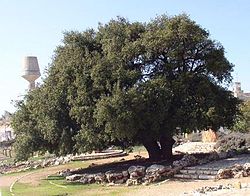Alon Shvut
Alon Shvut
אַלּוֹן שְׁבוּת | |
|---|---|
 Alon Shvut oak tree | |
| Etymology: Oak of return | |
| Country | Israel |
| District | Judea and Samaria Area |
| Council | Gush Etzion |
| Region | West Bank |
| Founded | 1970 |
Alon Shvut (Template:Lang-he-n) is an Israeli settlement located southwest of Jerusalem, between Bethlehem and Hebron in the West Bank. It is administered by the Gush Etzion Regional Council and serves as a regional center for the communities of the Gush Etzion region. The international community considers Israeli settlements in the West Bank illegal under international law, although the Israeli government disputes this.[1] In 2010, Alon Shvut had a population of 700 families.[2]
Etymology

Alon Shvut, literally "oak of return," is a reference to the return of the Jews expelled from Gush Etzion by the Jordanian Arab Legion in 1948 following the Kfar Etzion massacre. After the destruction of the Etzion Bloc of communities, the survivors and their children would gather yearly on the Israeli–Jordanian frontier to glimpse the sole remaining tree,[3] an oak, which became known as the "lone oak." The town was constructed adjacent to the oak, which is considered a symbol of renewal and continuity. The oak is incorporated in the municipal emblem.[citation needed]
History
Archaeological evidence of Jewish settlement from circa 300 BCE has been found in the Giv'at HaHish area, as well as later Byzantine‑era remains including a mosaic floor. Alon Shvut sits on the ancient road to Jerusalem, which is still marked by Roman milestones. Many mikvehs believed to have been used by pilgrims on the way to the Temple in Jerusalem scatter the surrounding hills, due to the location's proximity to Jerusalem — about a day's travel in those times. Dozens of ancient grape and olive presses, as well as cisterns hewn out of the bedrock, testify to a long history of agriculture.[citation needed] Alon Shvut is adjacent to the site of ancient Battle of Beth-zechariah.
Alon Shvut was founded in 1970 as a residential quarter for families associated with the then-nascent Yeshivat Har Etzion hesder yeshiva. It developed as a communal and service center in a predominantly agricultural region. [2] For many years Alon Shvut housed the only health clinic, grocery, post office and bank in the area.
Educational and religious institutions
Much of Alon Shvut's growth has been tied to the presence of Yeshivat Har Etzion. In addition to the families of faculty, many of its students have made their homes in the town. The Herzog College for Teachers is located in Alon Shvut. Tsomet Institute is a research institute based in Alon Shvut that seeks ways of reconciling Jewish religious law with modern technology to enable hospitals, police, fire departments and the military to carry out their duties on the Sabbath.[4]
Demography

In 2000, a second neighborhood doubled the size of the town to accommodate an increased demand for housing. Among the new residents were those who had been unable to acquire lots in the original neighborhood,[5] as well as many young families that had moved to Israel from abroad ("made aliyah"), especially from the United States. A third neighbourhood is planned for the Giv'at HaHish (גִּבְעֵת הִחִי"ש) area northeast of the town, named after the Haganah's HISH unit's operations there. In 2002, a group of 90 Incan Jewish immigrants from Trujillo, Peru moved into mobile homes on the site.[6]
Geography
Located in the northern Judean Hills at about 950 m above sea level, Alon Shvut is a cool and dry in summer. Winters are mild, with rainfall and a few inches of snow about once a year. The old and new neighborhoods are contiguous and lie on a northwest–southeast axis along the ridge of a hill, with a gradual plain descending to its south and dramatic gullies dropping to its north. The Givat HaHish neighborhood is on an extension of the ridge which abuts a gully to the northeast of the town.
Alon Shvut is located a few hundred meters west of the Gush Etzion Junction, where Route 60, the north–south artery which roughly follows the watershed from Nazareth through Jerusalem to Beersheba meets Route 367, which descends west into the Elah Valley to the coastal plain and Tel Aviv area. Travel time to Jerusalem is approximately 15 minutes.[2]
Local culture
The annual Bible-learning conference at Herzog College is a 5-day event that attracts thousands of participants from all over the country. In 2010, over 100 leading scholars delivered 150 lectures. [7]
References
- ^ "The Geneva Convention". BBC News. 10 December 2009. Retrieved 27 November 2010.
- ^ a b c Nefesh B'Nefesh Community Guide for Alon Shvut
- ^ העץ הבודד Kfar Etzion website
- ^ Alon Shevut Journal; Thank the Lord for Loopholes: Sabbath Is Safe
- ^ Communities in Israel Alon Shvut, NBN website
- ^ How 90 Peruvians became the latest Jewish settlers
- ^ Annual Bible learning conference kicks off in Alon Shvut
